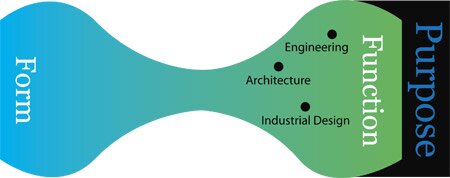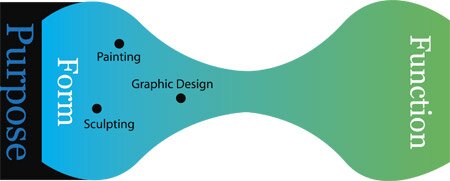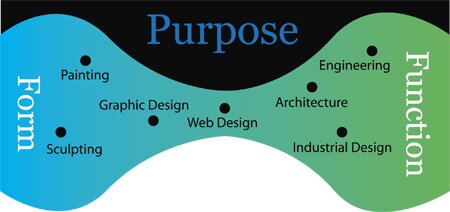Use the links below to share Function vs. Form: Rescuing Design from Insanity on your favorite social networks.
Back to the Article >>
Function vs. Form: Rescuing Design from Insanity
March 3rd, 2008 in Web Design Worldview
by: Matthew Griffin
The debate over function and form has raged in the design community for over a century and a half. Artists and craftsmen in every design discipline have wrestled, and continue to wrestle, with the tension of function and form every day. In web design this tension is especially pronounced because the success of our work requires an almost mathematical balance of function and beauty. That's why it's imperative we have a solid grasp on the history and philosophy that has shaped our own approach to solving this dilemma. Why function? Why form? Once I've answered those questions, I'll present the Christian worldview of design and briefly map out a practical Christian approach to design.
The Roots of Modern-day Design Philosophy
In the latter part of the 19th century, early pioneers of modern graphic design fell prey to the burgeoning modernist philosophy of their day. They began to hold up functional design as the only real design. As a result, ornamental style gave way to simple geometric shapes; intricate detail melted into flat planes filled with pure hues. But as their reductionist approach worked its way into mainstream design, its proponents realized that the new approach failed to satisfy the human desire for beauty. They struggled to explain why their design didn't work without eye-pleasing form. As the utilitarian modernist philosophies began to recede in the second half of twentieth century, the relativism of post-modernism gradually moved in to fill the void (I am referring to the the overarching worldview of post-modernism, not the graphic design style of the 1970s and 80s commonly called post-modernist design). But this new philosophy of design was eventually befuddled by the opposite question—why should our beautiful, subjective design be functional?

When a philosophy starts with nothing but matter in motion (modernism), ideas like beauty can't be explained. They can be denied altogether, written off as illusions created by complex evolutionary happenstance. But that isn't a satisfactory explanation of reality or humanity. As the realization of the absurdity sets in, the modernist ideology eventually digresses to a point where all function is rejected and replaced with complete relativism (post-modernism).
In the post-modern view, the definition of beauty changes from person to person; placing it safely on a high shelf where the modernist can't touch it. But when post-modernism's system of subjectivism is applied to reality, we run into another dead-end. After all, we must function as if truth is real. For example, try applying post-modern relativism to programming or engineering—it doesn't work. Again, we are left with a philosophy of design that is broken.
Designers, both at the peak and trough of this philosophical sine wave, have sought the unification of two worldviews that are irreparably broken—neither worldview can be applied successfully to all areas of life. A broken worldview will always end in a final state of absurdity.

Modernism and Post-Modernism Applied
The practical results of these two competing philosophies have been extreme and ridiculous. Modernist designers find the ultimate end of their philosophy in a solid black square printed on a canvas—the perfect symbol of unbroken unity. And way out in left field, the post-modernists find the end of their road in photographs of urinals and meaningless paint splatter. It's fortunate that most designers don't work these philosophies out to their logical conclusions. There is no place in reality for either of these approaches. In order to maintain a foot in reality, I've found that most modern graphic designers and web designers unwittingly hold both views simultaneously in an irrational tension. This tension keeps them from floating too far one way or the other, but as you will see, this irrational balancing act is unnecessary in the Christian worldview.
Reclaiming the Rulebook
Everyday, we should thank our creator, the triune God of the universe, that we have not been left to such deficient answers as those described above. Utility or beauty? Practical or Spiritual? Terrestrial or transcendent? Where should design reside? We have the answer, and it's time we started creating design culture that makes sense.
In order to do this we have to recognize and reject the assumptive foundation that's been imposed on us by modernist and post-modernist design philosophies. We must reestablish the highest category of design—"purposeful" design. In a Christian worldview, functional and beautiful design are sub-categories of purposeful design. Since Christianity finds the glory of God to be the goal and purpose of mankind, all design which accomplishes this goal is purposeful.
Similar to the humanist/modernist view, the practical aid of mankind (function) does fit into the Christian understanding of purposeful. But purposeful design also encompasses the realm of traditional fine arts (form). Fine arts, or "art for art's sake" as one famous designer labeled it, projects the majesty and complexity of the human mind. Ultimately this forces us to marvel at the designer of the designer, placing fine arts firmly in the purposeful category.
We see then that form and function are actually overlapping concepts—a spectrum. Neither can be completely extricated from the other. An overly simplistic view of the form/function model without the establishment of all-encompassing purpose will lead to an extreme, inappropriate, or repetitive application of style. At worst it will lead to the complete rejection of all design on one side of the function/form spectrum.

Applying Function and Form in a Christian Worldview
We've gone down a pretty deep well in this article but now we can clearly see that the Christian system of thought keeps us from going off the deep end while simultaneously providing an unbroken worldview that is intellectually satisfying.
With purpose at the core of every endeavor into web design, the ultimate purpose of each project should be considered before style and spatial composition are developed. Since purpose is the ultimate aim of any design, the level of function or beauty should follow purpose. Form should bow to function when the primary purpose of a work is to assist mankind. And function should concede to form when the primary purpose of a work is to display the creativity of the designer or craftsman. In either case, credit for design should always be deferred to the the giver of intelligence—the transcendent God.
The topic of Christian worldview in web design really deserves a more in-depth article, but I think this is a good starting point. I will continue to develop and explain the Christian view of web design in the months to come—most likely in the form of a multi-part series. Keep a lookout for that and please send me any questions or comments in the meantime.
- 27 Comments
- 9438 Views